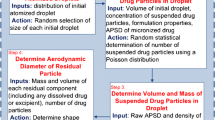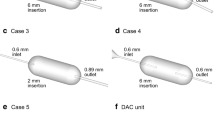ABSTRACT
Purpose
The objective of this study was to investigate the hygroscopic growth of combination drug and excipient submicrometer aerosols for respiratory drug delivery using in vitro experiments and a newly developed computational fluid dynamics (CFD) model.
Methods
Submicrometer combination drug and excipient particles were generated experimentally using both the capillary aerosol generator and the Respimat inhaler. Aerosol hygroscopic growth was evaluated in vitro and with CFD in a coiled tube geometry designed to provide residence times and thermodynamic conditions consistent with the airways.
Results
The in vitro results and CFD predictions both indicated that the initially submicrometer particles increased in mean size to a range of 1.6–2.5 μm for the 50:50 combination of a non-hygroscopic drug (budesonide) and different hygroscopic excipients. CFD results matched the in vitro predictions to within 10% and highlighted gradual and steady size increase of the droplets, which will be effective for minimizing extrathoracic deposition and producing deposition deep within the respiratory tract.
Conclusions
Enhanced excipient growth (EEG) appears to provide an effective technique to increase pharmaceutical aerosol size, and the developed CFD model will provide a powerful design tool for optimizing this technique to produce high efficiency pulmonary delivery.







Similar content being viewed by others
Abbreviations
- ACI:
-
Andersen cascade impactor
- CA:
-
citric acid
- CAG:
-
capillary aerosol generator
- CFD:
-
computational fluid dynamics
- DPI:
-
dry powder inhaler
- ECG:
-
enhanced condensational growth
- EEG:
-
enhanced excipient growth
- GC:
-
growth coefficient
- HFA:
-
hydrofluoroalkane
- HPLC:
-
high-performance liquid chromatography
- LRN:
-
low Reynolds number
- MDI:
-
metered dose inhaler
- MMAD:
-
mass median aerodynamic diameter
- MN:
-
mannitol
- MT:
-
mouth-throat
- NaCl:
-
sodium chloride
- RH:
-
relative humidity
- SD:
-
standard deviation
- TB:
-
tracheobronchial
REFERENCES
Longest PW, Hindle M, Das Choudhuri S, Byron PR. Developing a better understanding of spray system design using a combination of CFD modeling and experiment. In: Dalby RN, Byron PR, Peart J, Suman JD, Farr SJ, Young PM, editors. Proceedings of Respiratory Drug Delivery 2008. Illinois: Davis Healthcare International Publishing; 2008. p. 151–63.
Hindle M, Longest PW. Evaluation of enhanced condensational growth (ECG) for controlled respiratory drug delivery in a mouth-throat and upper tracheobronchial model. Pharm Res. 2010;27:1800–11.
Zhang Y, Gilbertson K, Finlay WH. In vivo-in vitro comparison of deposition in three mouth-throat models with Qvar and Turbuhaler inhalers. J Aerosol Med. 2007;20(3):227–35.
Cheng YS, Fu CS, Yazzie D, Zhou Y. Respiratory deposition patterns of salbutamol pMDI with CFC and HFA-134a formulations in a human airway replica. J Aerosol Med. 2001;14(2):255–66.
Leach CL, Davidson PJ, Bouhuys A. Improved airway targeting with the CFC-free HFA-beclomethasone metered-dose inhaler compared with CFC-beclomethasone. Eur Respir J. 1998;12:1346–53.
Byron PR, Delvadia RR, Longest PW, Hindle M. Stepping into the trachea with realistic physical models: Uncertainties in regional drug deposition from powder inhalers. Respir Drug Deliv. 2010;1:215–24.
Newman SP, Busse WW. Evolution of dry powder inhaler design, formulation, and performance. Respir Med. 2002;96:293–304.
Kamada AK, Szefler SJ, Martin RJ, Boushey HA, Chinchilli VM, Drazen JM, et al. Issues in the use of inhaled glucocorticoids. Am J Respir Crit Care Med. 1996;153(6):1739–48.
Borgstrom L, Olsson B, Thorsson L. Degree of throat deposition can explain the variability in lung deposition of inhaled drugs. J Aerosol Med. 2006;19:473–83.
Longest PW, McLeskey JT, Hindle M. Characterization of nanoaerosol size change during enhanced condensational growth. Aerosol Sci Tech. 2010;44:473–83.
Tian G, Longest PW, Su G, Hindle M. Characterization of respiratory drug delivery with enhanced condensational growth (ECG) using an individual path model of the entire tracheobronchial airways. Ann Biomed Eng. 2011;39(3):1136–53.
Longest PW, Hindle M. Numerical model to characterize the size increase of combination drug and hygroscopic excipient nanoparticle aerosols. Aerosol Sci Tech. 2011;45:884–99.
Ferron GA, Oberdorster G, Hennenberg R. Estimation of the deposition of aerosolised drugs in the human respiratory tract due to hygroscopic growth. J Aerosol Med. 1989;2:271.
Finlay WH, Stapleton KW. The effect on regional lung deposition of coupled heat and mass-transfer between hygroscopic droplets and their surrounding phase. J Aerosol Sci. 1995;26(4):655–70.
Finlay WH. Estimating the type of hygroscopic behavior exhibited by aqueous droplets. J Aerosol Med. 1998;11(4):221–9.
Zhang Z, Kleinstreuer C, Kim CS. Isotonic and hypertonic saline droplet deposition in a human upper airway model. J Aerosol Med. 2006;19(2):184–98.
Longest PW, Hindle M. CFD simulations of enhanced condensational growth (ECG) applied to respiratory drug delivery with comparisons to in vitro data. J Aerosol Sci. 2010;41:805–20.
Longest PW, Tian G, Hindle M. Improving the lung delivery of nasally administered aerosols during noninvasive ventilation - An application of enhanced condensational growth (ECG). J Aerosol Med Pulm Drug Deliv. 2011;24(2):103–18. doi:10.1089/jamp.2010.0849.
Longest PW, Kleinstreuer C. Computational models for simulating multicomponent aerosol evaporation in the upper respiratory airways. Aerosol Sci Tech. 2005;39:124–38.
Hindle M, Byron PR, Jashnani RN, Howell TM, Cox KA. High efficiency fine particle generation using novel condensation technology. In: Dalby RN, Byron PR, Farr SJ, editors. Proceedings of Respiratory Drug Delivery VI. Buffalo Grove, IL: Interpharm Press, Inc.; 1998. p. 97–102.
Dalby R, Spallek M, Voshaar T. A review of the development of Respimat soft mist inhaler. Int J Pharm. 2004;283:1–9.
Longest PW, Hindle M. Evaluation of the Respimat Soft Mist inhaler using a concurrent CFD and in vitro approach. J Aerosol Med Pulm Drug Deliv. 2009;22(2):99–112.
Longest PW, Hindle M, Das Choudhuri S, Byron PR. Numerical simulations of capillary aerosol generation: CFD model development and comparisons with experimental data. Aerosol Sci Tech. 2007;41:952–73.
Ghalichi F, Deng X, Champlain AD, Douville Y, King M, Guidoin R. Low Reynolds number turbulence modeling of blood flow in arterial stenoses. Biorheology. 1998;35(4&5):281–94.
Wilcox DC. Turbulence Modeling for CFD. 2nd ed. California: DCW Industries, Inc.; 1998.
Longest PW, Xi J. Condensational growth may contribute to the enhanced deposition of cigarette smoke particles in the upper respiratory tract. Aerosol Sc Tech. 2008;42:579–602.
Bird RB, Steward WE, Lightfoot EN. Transport Phenomena. New York: John Wiley & Sons; 1960.
Longest PW, Kleinstreuer C, Buchanan JR. Efficient computation of micro-particle dynamics including wall effects. Comput Fluid. 2004;33(4):577–601.
Longest PW, Xi J. Effectiveness of direct Lagrangian tracking models for simulating nanoparticle deposition in the upper airways. Aerosol Sci Tech. 2007;41:380–97.
Allen MD, Raabe OG. Slip correction measurements of spherical solid aerosol particles in an improved Millikan apparatus. Aerosol Sci Tech. 1985;4:269–86.
Morsi SA, Alexander AJ. An investigation of particle trajectories in two-phase flow systems. J Fluid Mech. 1972;55(2):193–208.
Gosman AD, Ioannides E. Aspects of computer simulation of liquid-fueled combustors. J Energ. 1981;7:482–90.
Crowe CT, Troutt TR, Chung JN. Numerical models for two-phase turbulent flows. Annu Rev Fluid Mech. 1996;28:11–43.
Matida EA, Nishino K, Torii K. Statistical simulation of particle deposition on the wall from turbulent dispersed pipe flow. Int J Heat Fluid Flow. 2000;21:389–402.
Matida EA, Finlay WH, Grgic LB. Improved numerical simulation of aerosol deposition in an idealized mouth-throat. J Aerosol Sci. 2004;35:1–19.
Ferron GA. The size of soluable aerosol particles as a function of the humidity of the air: Application to the human respiratory tract. J Aerosol Sci. 1977;3:251–67.
Ferron GA, Kreyling WG, Haider B. Inhalation of salt aerosol particles - II. Growth and deposition in the human respiratory tract. J Aerosol Sci. 1988;19(5):611–31.
Hinds WC. Aerosol Technology: Properties, Behavior, and Measurement of Airborne Particles. New York: John Wiley and Sons; 1999.
Li W, Hopke PK. Initial size distributions and hygroscopicity of indoor combustion aerosol particles. Aerosol Sci Tech. 1993;19:305–16.
Robinson R, Yu CP. Theoretical analysis of hygroscopic growth rate of mainstream and sidestream cigarette smoke particles in the human respiratory tract. Aerosol Sci Tech. 1998;28:21–32.
Fuchs NA, Sutugin AG. Highly Dispersed Aerosols. Ann Arbor: Ann Arbor Science Publ; 1970.
Finlay WH. The Mechanics of Inhaled Pharmaceutical Aerosols. San Diego: Academic; 2001.
Green DW. Perry’s Chemical Engineers’ Handbook. New York: McGraw-Hill; 1997.
Longest PW, Vinchurkar S. Effects of mesh style and grid convergence on particle deposition in bifurcating airway models with comparisons to experimental data. Med Eng Phys. 2007;29(3):350–66.
Vinchurkar S, Longest PW. Evaluation of hexahedral, prismatic and hybrid mesh styles for simulating respiratory aerosol dynamics. Comput Fluid. 2008;37:317–31.
ACKNOWLEDGMENTS
This study was supported by Award Number R21 HL104319 and R01 HL107333 from the National Heart, Lung, And Blood Institute. The content is solely the responsibility of the authors and does not necessarily represent the official views of the National Heart, Lung, And Blood Institute or the National Institutes of Health.
Author information
Authors and Affiliations
Corresponding author
Rights and permissions
About this article
Cite this article
Longest, P.W., Hindle, M. Condensational Growth of Combination Drug-Excipient Submicrometer Particles for Targeted High Efficiency Pulmonary Delivery: Comparison of CFD Predictions with Experimental Results. Pharm Res 29, 707–721 (2012). https://doi.org/10.1007/s11095-011-0596-1
Received:
Accepted:
Published:
Issue Date:
DOI: https://doi.org/10.1007/s11095-011-0596-1




